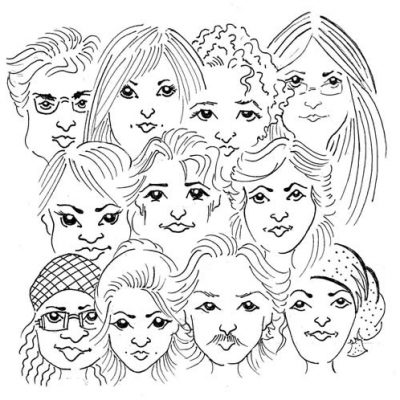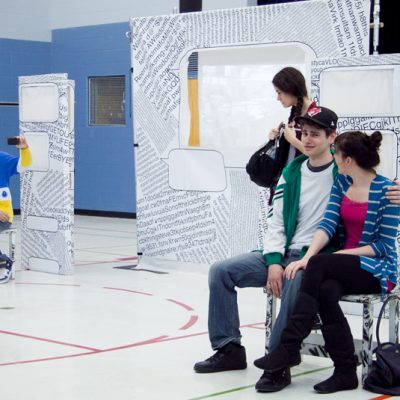Starring the cast of SHOWDOWN 2.0. In order of appearance: Tayves Fiddis, Nathan Barrett, Michelle Nash & Michelle Jedrzejewski. Photos by Erin McCluskey.
Our On/Offline World
With the first leg of the Showdown 2.0 tour finished, I have been thinking a lot about cyber-bullying and the boundaries between our online worlds and our offline realities. The online world has become an extension of our offline world. Our constant use of social networks has allowed the Internet to develop into a space where family, friends, and colleagues connect to each other on a whole new level. Online users are able to share as much or as little about their lives on personal profile spaces, for example, one’s Facebook profile page or Twitter feed. Often the things that we post online not only depict our interests and comment our personal beliefs, but also describe the relationships that we keep. Even though one may not put much thought into posting a vacation with close friends to a resort in the Bahamas, it tells the audience that the person is financially able to go on vacation, likes to travel, is adventurous, and has similar friends. What we post and don’t post about ourselves and others allows online viewers to get a sense of our offline world.
Our online world reflects aspects of our offline world, but we can choose what we post online. On the other hand, we cannot choose what others post about us. A person may have gone on vacation with his or her friends, photos may have been taken, and one of those friends may choose to post the photos online. Often we don’t ask if others are comfortable if we post images, information, or comments about them on our social networks. What we do in our offline world is represented in our online communities, which makes it difficult if we want to remain anonymous.
A couple of months ago my father decided to get Facebook because a family member from overseas had suggested that he sign up so that he can see family pictures that she posted on her account. My father decided to sign up so that he could keep in touch with family and friends that live far away. I helped him through the process, which was difficult as he was frustrated by all of the information that he was asked to share. We finally got through it. He was all set up, no profile picture, no interests posted, and about only 6 friends. My father recently had his birthday and those 6 friends sent kind messages to his Facebook wall. He received emails and asked me how to sign onto his account so that he could read the messages. When we signed on he had about 20 ‘friend requests’ from people he knew. My father was completely overwhelmed. I explained to him that he must reply, otherwise it is like not returning a phone call, or not answering the door when a friend knows you’re home. Feeling very overwhelmed, he explained, “I just wanted to see those pictures! This is too much for me.” Facebook wasn’t for my father, and I unfortunately helped him delete his account.
When participating in online networks we must think about how our online information connects to the outside world. Just like what we wear, how we behave, and what we say informs others about who we are, what we post also allows others to understand how we depict ourselves, our interests, and our beliefs. This forced connection between our online and offline worlds is hard to bear for some, but may allow for those who choose to connect to social networks to be responsible for what they post online.
Carina Cappuccitti
Week 1 of Showdown 2.0 under our belts!
First week. Seven shows. Showdown 2.0 is hitting it out of the park.
Check out what intern, Janie Pinard, has to say about the show:
I had the opportunity to get a sneak peek of the rehearsal process of Mixed Company Theatre’s Showdown 2.0. I saw the set and thought: practical. It is simple; it’s multipurpose, it can create different settings like a hallway or a cafeteria, and the design gives you a hint of the theme of the play – cyber-bullying. Next, I got to see the actors in action. It was interesting to see them explore with their characters and the set, along with their new costumes. The script was written to have the “worst case scenario”, but as a recent high school graduate, I saw many similarities and realistic situations, which makes it very easy to relate to. From what I saw in rehearsal, they have a well thought out set, a powerful message, a passionate team and hard working actors. The students are going to love it!
With all the media coverage of bullying, cyber-bullying and teen suicides as a result of bullying – the timing couldn’t be more relevant for this performance. Are you a student or educator who has seen Showdown 2.0? Comment and let us know what you thought!
By Deidre Budgell & Janie Pinard
Deidre joined MCT as Administrative Coordinator in 2010 after completing her M.A. in Theatre Studies at York University and has since moved up the ranks as Communications & Outreach Coordinator. By day Deidre’s committed to research and arts administration, but by night she enjoys moonlighting as a stage manager, having worked in Toronto and extensive work in her native St. John’s.
Janie Pinard was given the Rising Star award by Mixed Company Theatre and is now doing an internship at MCT because of her passion for promoting health among her peers and community and her passion for theatre. She worked at the Sudbury & District Health Unit as a Youth Program Advisor to assist the school health promotion staff in modifying their programming to better meet the needs of the youth in the community. Her recent credits as an actor are Mimi and choreographer in Y.E.S. Theatre’s RENT, Catherine in le TNO’s production of Les Huit Femmes, Jeannie and choreographer in Y.E.S theatre’s HAIR and Arielle in Living a Deadus Danslavillus.
DISconnected
Although MTV is famous for their reality shows geared for teens such as, Jersey Shore, the television network has always been ahead of the curve in presenting relevant topics that impact a wide range of North American youth. Most recently, MTV decided to raise awareness to the issue of cyber-bullying. During the same week that MTV’s movie DISconnected premiered, CNN’s Anderson Cooper introduced a special about bullying. In any current parenting magazine articles depicting tragedies due to bullying are the main feature.
Of the coverage on bullying, MTV’s DISconnected is one of the few resources made for young audiences. Much of the media attention focused on bullying does not examine the impact that Internet, mobile phones, and other forms of technology have in allowing for bullying to go unnoticed.
DISconnected brings insight to the various forms of technology that American youth are connected to. As the movie develops the audience quickly learns the high degree in which youth are connected to each other through technology. The theme that technology is a form of communication that exists at every hour of the day is shown in complex ways. Many of the characters struggle to choose when and when not to communicate with others. The audience learns that a person no longer controls when he or she may be contacted. Technology can be consuming when trying to keep up, and wait for or give responses to others. Characters in the movie must cope when information that they do not want to be public is posted about them. As technology allows for unrestricted communication to be sent out and received constantly, we cannot escape from others contacting us and cannot control if information about ourselves exists on the public online world.
DISconnected successfully presents the way in which we are connected to each other and reveals the ways in which this online connection can cause tension in our offline world relationships. Our online ‘connectedness’ also forces tensions that in fact turn to bullying and harassment. DISconnected allows it’s audience to think about the limits that exist in the online world and what our role is when we are subject to bullying or notice bullying. Although teachers and other authority figures may not have access to monitor cyber-bullying, students are connected to each other and must come to understand the impact that bullying has on it’s victims and aggressors. DISconnected is a great source for youth to begin to understand their role in ensuring that bullying must not be accepted and must be reported.
By Carina Cappuccitti
Carina is a Masters of Education student at York University. She is focusing her studies on the ways that media and popular culture influence young peoples understanding of gender. Carina has a Bachelors degree in Education and Theatre and is so happy that she is able to combine her two passions while interning at Mixed Company.



